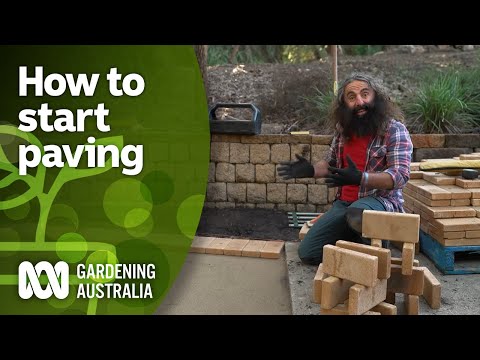
How to pave and different paving styles explained | DIY Garden Projects | Gardening Australia
Costa loves paving and says it’s not that difficult to lay yourself, once you know how to do it. So he prepares to pave the way for us to learn! Subscribe 🔔 http://ab.co/GA-subscribe
First look at the area you’re in and assess what job the pavers are doing – is it a path between garden beds? how heavy is the traffic? Will cars need to drive on it? The more reactive the soil and the higher the use of the pavers, the more reinforcement will be needed to make sure the pavers can handle the pressure.
Also consider the style you want: brick is durable for a driveway and a herringbone pattern helps lock them together. In a footpath, brick is also an option, as is crazy paving, but be warned – this needs patience to work with pieces of different thickness. Sandstone gives a more natural look but it’s porous and can stain.
Costa is using terracotta pavers to create a short paving link between a path and a concrete slab.
What you’ll need:
Pavers
Road base gravel
Sand
Spade
Rake
String lines (at least two)
Square metal rails (optional)
Spirit level
Gloves
Floater
Calculate volume of sand/gravel by multiplying the surface area of the path you want to cover by the depth of the sand/gravel (see below). If in doubt, take your measurements to your local supplier, who should be able to help.
What you do:
1. Measure the space you’re working with to calculate the number of pavers you need.
2. Pavers are only as good as the base so preparation is key. Calculate working down through the layers you’ll need to estimate the depth you need to dig and prepare. Costa adds up: pavers at 40mm, then below that 25mm of paving sand, plus about 75-100mm of road base at the bottom – so all up about 160mm depth.
3. Level the ground with a rake then compact the surface before you start and again at each layer.
4. Set a string line up to mark out the boundaries of the path.
5. Use square metal rails to act as train tracks on either side of the pathway; this helps set up the levels you want (you can create a slight fall towards a garden bed to direct rain, for example) and to check the base and sand are completely flat as you lay them. If you have some gaps they’re easy to fill with a handful of sand and a wooden float
6. When you’re happy with the surface of the sand, remove the rails (if using), fill the void with sand, and start laying the pavers.
7. It’s a good idea to wear gloves to protect your hands.
8. Pick one corner as your beginning point and set an edge to your path, following the string line, and remembering that there is a top and bottom to most pavers; the top has slightly curved edges.
9. Start the herringbone or other preferred pattern; you may need to add a few more string lines through the middle to keep everything lined up and straight.
10. When finished, if you’re butting up against an angled ending, you may need to measure and mark off a line to place a ‘header’ line of pavers to square it off; you may need to cut some pavers to make this fit. (see video)
11. Costa demonstrates how to put a ‘haunch’ of cement under and against the paver edges to ensure they stay in place, neatening it up with a floater tool.
___________________________________________
Gardening Australia is an ABC TV program providing gardening know-how and inspiration. Presented by Australia’s leading horticultural experts, Gardening Australia is a valuable resource to all gardeners through the television program, the magazine, books, DVDs and extensive online content.
Watch more: http://iview.abc.net.au/programs/gardening-australia
Facebook: http://www.facebook.com/gardeningaustralia
Instagram: http://www.instagram.com/gardeningaustralia
Web: http://www.abc.net.au/gardening
___________________________________________
This is an official Australian Broadcasting Corporation YouTube channel. Contributions may be removed if they violate ABC’s Online Conditions of Use http://www.abc.net.au/conditions.htm (Section 3).









